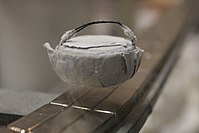
Photo from wikipedia
In topological insulator edges, the duality between the Zeeman field orientation and the proximitized superconducting phase has been recently exploited to predict a magneto-Josephson effect with a 4$\pi$ periodicity. We… Click to show full abstract
In topological insulator edges, the duality between the Zeeman field orientation and the proximitized superconducting phase has been recently exploited to predict a magneto-Josephson effect with a 4$\pi$ periodicity. We revisit this latter Josephson effect in the light of this duality and show that the same 4$\pi$ quantum anomaly occurs when bridging two spinless Thouless pumps to a p-wave superconducting region that could be as small as a single and experimentally-relevant superconducting quantum dot - a point-like defect. This interpretation as a dual Josephson effect never requires the presence of Majorana modes but rather builds on the topological properties of adiabatic quantum pumps with Z topological invariants. It allows for the systematic construction of dual Josephson effects of arbitrary periodicity, such as 4$\pi$ and 8$\pi$, by using point-like defects whose symmetry differs from that of the pump, dubbed symmetry defects. Although adiabatic quantum pumps are typically discussed via mappings to two-dimensional geometries, we show that this phenomenology does not have any counterpart in conventional two-dimensional systems.
Journal Title: Physical Review B
Year Published: 2019
Link to full text (if available)
Share on Social Media: Sign Up to like & get
recommendations!